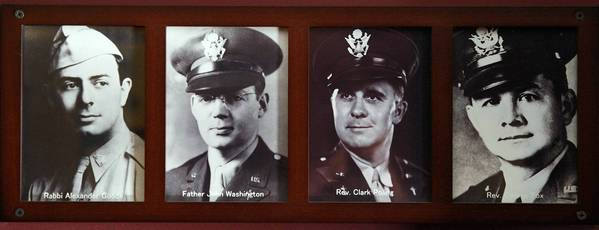I remember walking into Post 283 for my first meeting of the Sons of the American Legion and seeing the mementos and photographs in the display case inside the front door.
Most of them were self-explanatory, but one of them was a mystery to me. It was four separate photos of four men, each in uniform, but I couldn’t see the connection between them.
Someone told me that it was the “Four Chaplains” and gave me a brief summary of their story, which was apparently quite well known in the 1940s and 1950s. I had forgotten the story until I saw Monday’s Los Angeles Times. I recognized a familiar photo:
 Four Chaplains – 70 Years Ago, Chaplains on a Sinking Ship Took Off Their Life Vests and Gave Them Away
Four Chaplains – 70 Years Ago, Chaplains on a Sinking Ship Took Off Their Life Vests and Gave Them Away
The article is entitled “Remembering Four Chaplains’ Selfless Heroism” and takes us back to February 3rd, 1943:
[Four] men of different faiths, arms linked in prayer, braced against the waves engulfing the deck of their torpedoed troop ship on Feb. 3, 1943. They had given their life preservers to frantic soldiers and urged troops paralyzed with fear to jump into the icy North Atlantic before they were sucked down by the sinking ship’s whirlpool.
[…]
Eleven nights after the Dorchester’s voyage began, a German torpedo ripped open its hull. Men choked on ammonia pouring out of a refrigeration system and drowned as oily seawater poured into their cramped quarters below deck. Many who scrambled out after the 1 a.m. blast were clad only in their underwear, having ignored orders to sleep fully clothed, with life jackets at the ready, while crossing submarine-infested waters.
On deck, the chaplains led dozens of frightened soldiers to a cache of life vests before giving away their own. It took only 20 minutes for the Dorchester to sink. Rescuers on nearby ships saw hundreds of blinking red lights — life jacket signals bobbing beside the corpses of men who had frozen to death in the 34-degree waters 80 miles off Greenland.
Afterwards, their story was famous and in some cases, controversial:
A postage stamp in 1948 honored the two Protestant ministers, the Catholic priest and the rabbi. Streets and schools soon were named after them, a chapel in Philadelphia dedicated to them, books written about them. Testimonials to their self-sacrifice were lavish; President Truman said, “I don’t think in the history of the world that there has been anything in heroism equal to this. It was the greatest sermon ever preached.”
[…]
When word of the clergymen’s unity arrived home, it struck a nation where prejudice against Catholics and Jews had been pervasive. Just 10 years before, the National Conference of Christians and Jews sent out the first of its many “tolerance trios” — a rabbi, a priest and a minister preaching interfaith harmony. The first trio had to cancel in Chicago and Cincinnati because local Catholic bishops objected to a shared platform.
Today, the memory of their story has faded:
But 70 years after one of World War II’s most celebrated episodes, the story has faded, kept alive these days mainly by veterans groups, history buffs and family members of the 672 men who died in the sinking of the ill-fated Dorchester. Only 230 survived. The last among them died Jan. 12 at age 91.
The article reminded me of the Sons’ Living History Series. It’s up to us to remember these stories and tell them to those who were not alive or too young to remember. Only then can we truly honor the sacrifices of our Veterans.
Bill Bliss
12 February, 2012
{ 0 comments… add one now }